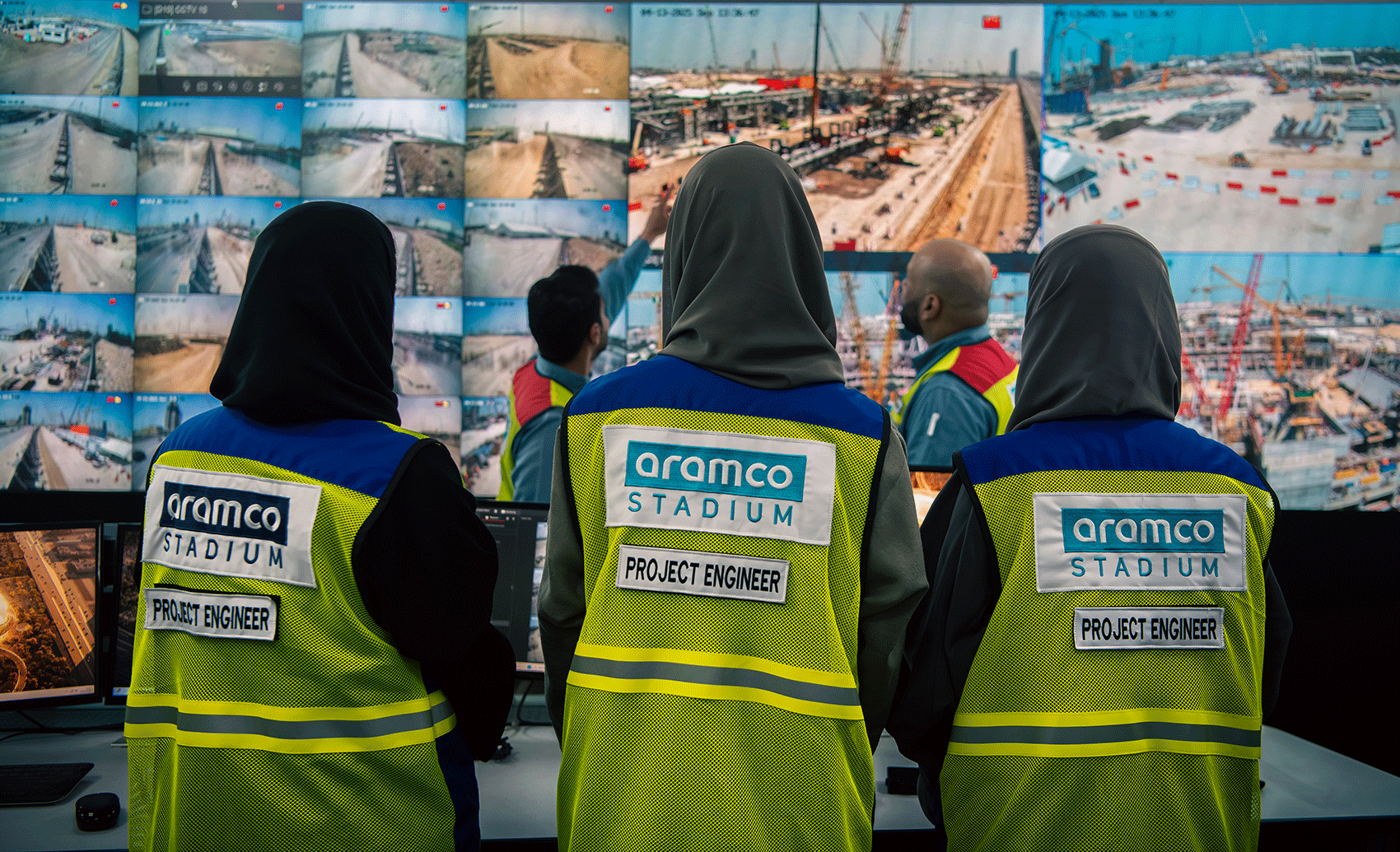As the developer of Aramco Stadium, Aramco promotes a rigorous health and safety standards at the 47,000-seat sports stadium. From the first shovel of dirt at ground-breaking to the first cheers of opening day, we aspire to build a world-class stadium in accordance with the strictest safety standards in the world.
It’s a daunting task, but critical to the project’s success. After all, safety is about ensuring everyone returns home safely.
Priority of Safety
In the construction phase, the Stadium project site bristles with 74 cranes lifting and putting into place concrete and steel components that one day will host tens of thousands of sports fans from around the world. Currently, more than 6,000 workers operate in shifts, 24 hours a day, performing tasks such as welding, operating heavy equipment, and guiding massive components into place, logging an astounding 6.38 million manhours of work toward the goal of project completion by 2026.
In addition to this impressive work, Aramco’s project workforce is building something equally powerful: a unified safety mindset among thousands of workers working for 32 separate subcontractors.
You see this safety mindset in the daily rhythm of safety briefings, from the 4,000 training sessions conducted so far, to the structured safety induction for new workers, the daily pre-task safety briefings, and the toolbox talks, all of them focusing not only on the task ahead, but on the careful, responsible, disciplined way in which that task is carried out.
Knowledge is power, and all workers on site – Aramco employees and contractors alike – are empowered to intervene, correct, and recognize safe practices, reinforcing the safety mindset from the ground up.
Leveraging technology
The project’s safety culture is also being shaped by technology. At its heart is a smart Safety Command Center outfitted with AI-based monitoring. The ongoing implementation of 360° proximity cameras, anti-collision crane systems, and hook-mounted cameras continues to enhance real-time situational awareness.In the Safety Command Center (SCC), safety observers monitor a wall of television screens with live camera feeds from all parts of the Stadium worksite. The cameras have 360-degree viewing, which provides real-time visibility of safety observations and inspections. If a workman on site neglects to wear a helmet, or is working at height without a harness, an alarm will sound. The SCC will call the man’s supervisor to remediate the situation. The system has the capacity to provide smart helmets to every worker, allowing SCC officers to contact workers directly, telling them to stop work and to meet their supervisor, and receive instruction on proper safety practices.
Through the OASIS digital platform, the team maintains real-time visibility across inspections, audits, and safety observations, allowing swift action and system-wider learning.
For inspections, we are mitigating risks to our people by utilizing drones to monitor the quality of work that is completed at height.
One team, one standard
Aramco safety officers are present on site monitoring the implementation of safety procedures in critical tasks, such as the movement of heavy equipment, heavy lifts, and rigging.
With 32 separate subcontractor companies on site, each with their own safety procedures, our safety officers make sure that all work on site is aligned by the same safety standards. Safety requires buy-in more than mere compliance, so Aramco and its partners hold recognition ceremonies to recognize positive behaviors, giving awards and incentives to teams that lead by example.
Safety Beyond the Site
Health and safety are not confined to the construction zone. Aramco and its subcontractors carry out regular meetings to align on health and wellness for the workforce. To ensure the welfare of contractors, who at the project peak may number more than 10,000, training sessions are held for workers and supervisors to be vigilant about working in high temperatures. Workers are trained to recognize the signs of heat stress, take actions to avoid it, know when to rest or seek shelter, and understand the steps to take if a member of their team needs medical assistance. Temperature sensors with alarms were installed to warn when dangerous heat levels could impact the health of workers.
Site mess hall facilities are provided and catering requirements are enforced to ensure workers have access to hot and safe meals. Designated shaded rest areas were built and portable fans, electrical water coolers, water thermoses, personal drinking bottles are also provided to workers. The welfare provisions also include personal drinking bottles and adequate access to washing facilities and toilets.
Off site, regular inspections of worker accommodation to ensure that workers’ well-being is looked after, both on and off the job.
